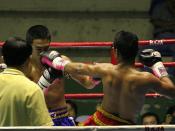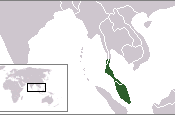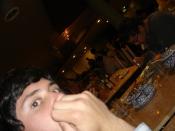The official name is the Kingdom of Thailand. This country, centered
around its capital Bangkok, has 198,456 square miles. Within these
boundaries there are 54,862,000 people which roughly is 276.4 people per
square mile. 19.8% is urban and 80.2% is rural. This country is divided into
72 provinces.
Thai is the language that is spoke throughout this country and
Buddhism is officially taught. 88.8% of Thailand's people are literate. The
governing body consists of a constitutional monarchy and is run by the king.
The legislature is organized by a national assembly.
Geographically, the biggest peak is Doi Inthanon and the lowest point
of elevation is sea level. The major rivers that flow through Thailand are the:
Chao Phyraya, Chi, Mekong, Mun, and the Ping.
Thailand is 985 miles north to south and 510 miles east to west.
Burma borders Thailand on the north and west (across the Salween River),
on the north and east by Laos (across the Mekong River), and on the south
(across the Isthmus of Kra) by Malaysia.
There is 1200 miles of coastline
along the gulf of Thailand, which leads into the south China Sea. The
western side of the Malay Peninsula is by the Andaman Sea. The Thai
people describe their land as:
'An elephants head'
- The trunk is in the south.
- The ears in the north.
- The mouth is in the delta and harbor of the Chao Phyraya
River.
- The central plains of the river basis is where the eyes and
brains are located.
The vegetation of Thailand contains such plants as; rice, 250 varieties
of bamboo, coconut palm, banana plants, orchards of durain, mango,
rambutan, litchi, mangosteen, papaya, and a variety of other fruit plants.
The entire region is formed by sediment deposits by the Chao Phyraya
River. This river provides irrigation water and fertile soil for rice. The crops
of the region: tapioca in the southeast, corn in the bordering hills, and
although the plains product no mineral wealth, the mountainous borders
produce such goods as sapphires, fluorite, and tungsten.
The valleys of the northern highlands were stripped of there natural
vegetation and replaced with rice, fruits and tobacco. The mountain land was
cleared by lumbering and farming. These mountain offer teak as well as
other tropical woods.
The northeast is in the Khorat Plateau. These include the low hills and
the central plains by the Mekong River. The mountains that separate the
plateau from Cambodia is the scene for a lot of guerrilla warfare. This land
is know for its livestock production. Animals were once breed for aid in the
rice crops and to plow fields. Elephants are still used in the transportation of
lumber. The main mineral in the northeast is rocksalt.
The south is on the mountains of the Malay Peninsula and extends
through the Isthmus of Kra. There is a massive amount of people that farm
rice in the river valleys and along the eastern river plains. Thailand fishing
fleet is very modernized and this results in major export of shrimp, squid, and
cuttlefish. the one problem that has arose with all of this is the over fishing
along the coast of Thailand.
The climate of Thailand is a monsoon, or a wet / dry climate. From
May to October there is seasonal wind, monsoon, which produces hot and
humid days and at least 40 inches of rain. This is 90% of the years total
rainfall. In October the monsoon brings a cool dry season, which is a
favorite of the Thai people. Starting in March the sun gets warm and the
weather starts to get dry.
In the southern regions there are more than 1,000,000 Malay speaking
Muslims. In the mountainous Myanmar border the Karens live in isolation.
There are other hill tribes, among them the Hmong and Yao, that live in the
northern mountains. In the northeast, near the Cambodian border, thousands
of Khmers live there and have for centuries. Most of the people in the
northeast are Lao, a separate group of Thai people. Every village in the Thai
culture has a Wat, or temple complex. It is similar to a Christian Church,
there is a gathering hall and a living place for the Monks. This Wat is where
they have festivals, sports programs and social 'get togethers'.
The Thai new year is in April and is celebrated by symbolically
washing sins away and blessing friends with water. Young people celebrate
by getting people and vehicles wet with garden hoses.
Thailand is a competitor in major sports events. They are active in
such sports as: soccer, boxing, and field hockey. Bangkok has hosted the
Asian games several times. A very popular sport in Thailand is the art of kite
flying. This is where male and small female kites do acrobats in the pre-
monsoon winds.
India and China have a lot of influence on the Thai culture. There are
dancers that dance to classic stories ,such as the Indian tale 'Ramayana', but
the music used in this epic is not of Indian origin, it originates from the
stringed instruments of China. There are many traditional arts which are kept
alive by tourism such as: enameling and etching silver, and dying silk. The
most intriguing cultural tradition, that is kept alive by tourism must be the
age old tradition of placing rings around women's necks. This is done as a
sign of age and growing maturity. This practice was stopped for awhile
because over the years, as more rings are added, the pressure pushes down on
the collar bones and finally breaks them, which usually results in death.
Tourists pay good money to come see this popular attraction and merchandise
is even marketed to keep this tradition alive.
Bangkok is the center of this country and acts as the economic and
political capital also. This capital city contains 12% of the countries
population and acts as a major port. This city is also 'a center for higher
learning, medical services, banking, and religion.' This city has its down
sides too with air pollution and traffic jams. Overcrowding and poor slums
are also a problem, as with any major city. Bangkok is also the center of
transportation and communication. As far as transportation, there is 'a
network of navigable rivers and canals' that transport such goods as: logs,
rice, and charcoal. Railroads are also used as a form of transportation five
main lines branching out from Bangkok.
In Thailand there is approximately 56% of the population that is
employed. Half of which is women.
-One third of the people are employed in forestry, hunting, and fishing
-9% works in manufacturing
-another 9% in commerce
-10% in the service industry
It is necessary that all children between the ages of seven and fourteen
be enrolled in the education system. There are 16 universities and technical
institutes in Thailand. Children learn about their Thai culture which dates
back to about the 13th century with the first written literature and the
introduction of Thai writing. In this centuries the arts started to become a big
part of the culture which is now reflected in the many temples.
There are many health issues in Thailand. AIDS has become an
epidemic all throughout Thailand. As recorded in 1988 there are 102,374
hospital beds and 11,260 physicians.
The life expectancy among the Thai people is:
-Women live until approximately seventy one
-Men live until approximately sixty seven
The infant mortality is thirty five out of 1000 live births
Thailand's major trade partners are:
-Japan
-The United States
-Singapore
-Germany
The currency exchange is 1 Baht = 100 Satangs
Thailand has many interesting features and cultures that are very intriguing to
many people. Thailand is becoming a major tourist attraction for many of
the Asian countries. They are now promoting the beauty of the land in the
hopes to bring foreign dollars in through the tourist.
I hope one day I will have the opportunity to visit Thailand and
exexperience the culture first hand.
Bibliography
-Grolier's 1993 Encyclopedia
-Collier's Encyclopedia Vol.#22
-Compton's Encyclopedia Vol.
#23


